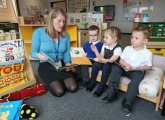Sensorial resources play an important role in developing children’s understanding of numbers, shapes and patterns, says Barbara Isaacs…
It is curious that mathematics causes so much concern as children progress through school, as they are introduced to the language of numbers and feeling of shapes from their first year of life. They get used to seeing numbers and learn to recognise those most relevant to them, for example, their age as represented by candles on birthday cakes. The language of number and the shape of numerals are in everyday use, and it is common for a three-year-old to be able to recite the number sequence from one to 10 and identify the channel that will deliver CBeebies. Equally, they become familiar with shapes such as spheres, cubes and square or triangular-based prisms by posting them into boxes or threading them as they sort the shapes by colour.
These early introductions to mathematics, simplistically explained as the science of number, shape and pattern, are enhanced by rhymes, songs and books in which the child begins to make links between the numeral and quantity through one-to-one correspondence.
In early years settings these activities are enhanced by counting objects and, where possible, linking them with the relevant numerals – for example, counting conkers into containers marked with numerals. There are, of course, many other activities in the daily life of a setting – such as counting the number of children present – that introduce numerical language and give opportunities to experience simple addition and subtraction.
In Montessori settings, all the scenarios described take place alongside specific activities designed by Montessori herself. They support the child’s need to combine quantities with numerals and give the child a better understanding of what the number names spoken and symbols really mean. In our settings, we always start by counting objects and linking them with names. The child gradually comes to grasp the cardinal quality of the number; practically this means that the name ‘four’ represents four objects, such as four candles on their birthday cake. (It is not four if there are two candles and two birthday cards, even though there are four objects in front of the child.) Furthermore, for the first activity we use the number rods, where the 10cm sections in alternating red and blue colours represent the quantities by being fixed, joined together so the repeated sections can only be four, encouraging the child to touch each section as they name it one, two, three four. When the child recognises the numeral 4, they are also able to place it with the rod – so combining the quantity with the symbol.
Subsequent games with the rods and cards enable the child to consolidate their understanding of the number base of 10, thereby introducing them indirectly to the decimal system. The rods can also be used to measure objects, for example, plants grown in the garden.
According to Montessori, the child is born with a mathematical mind, which can be explained as their genetic capacity for logical thinking and problem-solving. For the child to develop these natural predispositions, it is necessary to have opportunities to employ them in the environment.
In Montessori settings these are provided by the activities of everyday living and also in the sensorial area. Children make patterns when threading beads and sort shapes into containers, often using colours as a guide – early steps towards understanding what sets are that guide the child indirectly towards later work with multiplication.
Sequencing shapes by size, as done with the pink towers, broad stair and long rods, are activities that are at the heart of the sensorial education. The muscular impressions children receive during the manipulation of these shapes underpin the conceptual understanding of shape. For Montessori “the hand is the instrument of man’s intelligence”. Observing children with these activities leaves us in no doubt about their value in contributing to the child’s mathematical understanding of their environment.
MCI offers distance learning Level 3 & 4 Diplomas in Montessori pedagogy – Birth to Seven (Early Years Educator). Visit montessori.org.uk/mci-training

Keep SLC on top of the agenda
Editors picks

Play-based learning – Approaches from around the world
Editors picks
